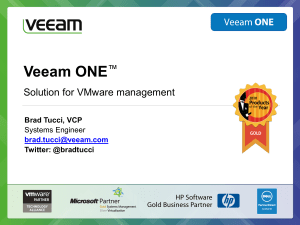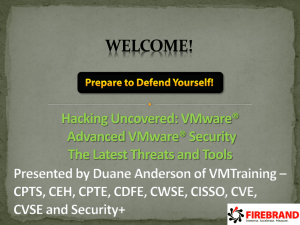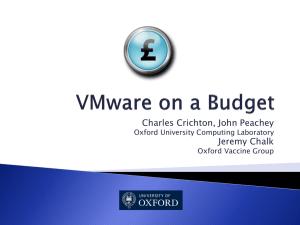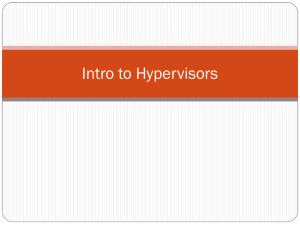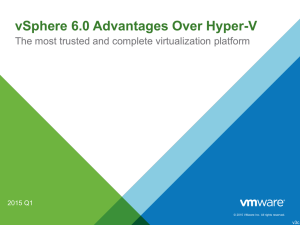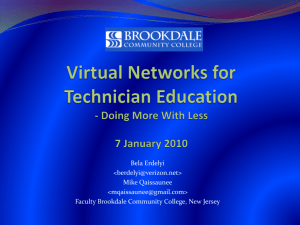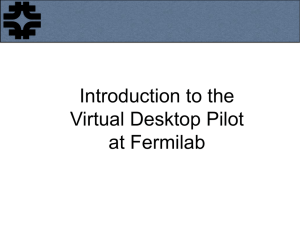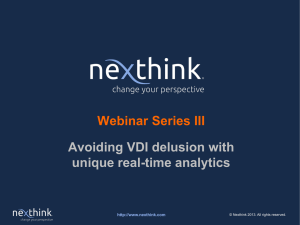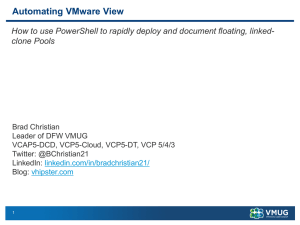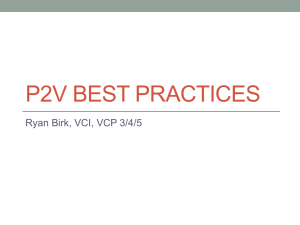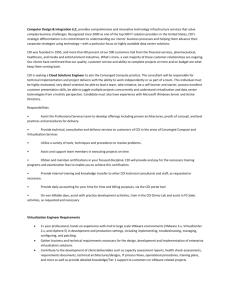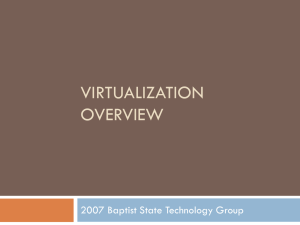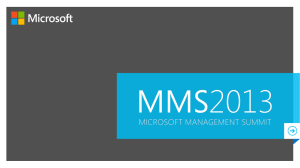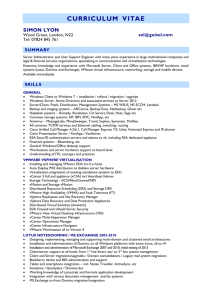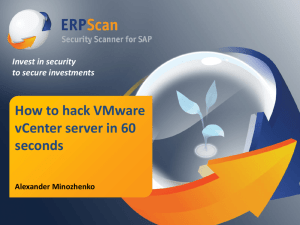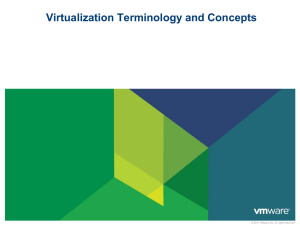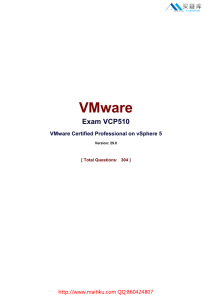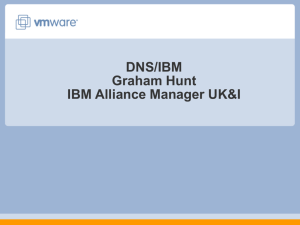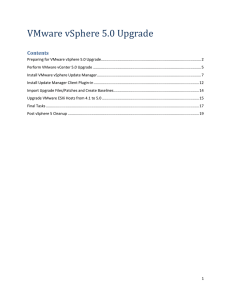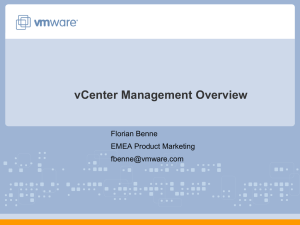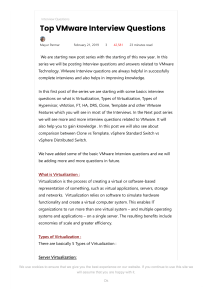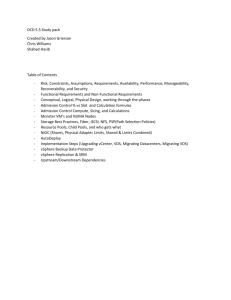VMware vSphere 4.1 with ESXi and vCenter
advertisement
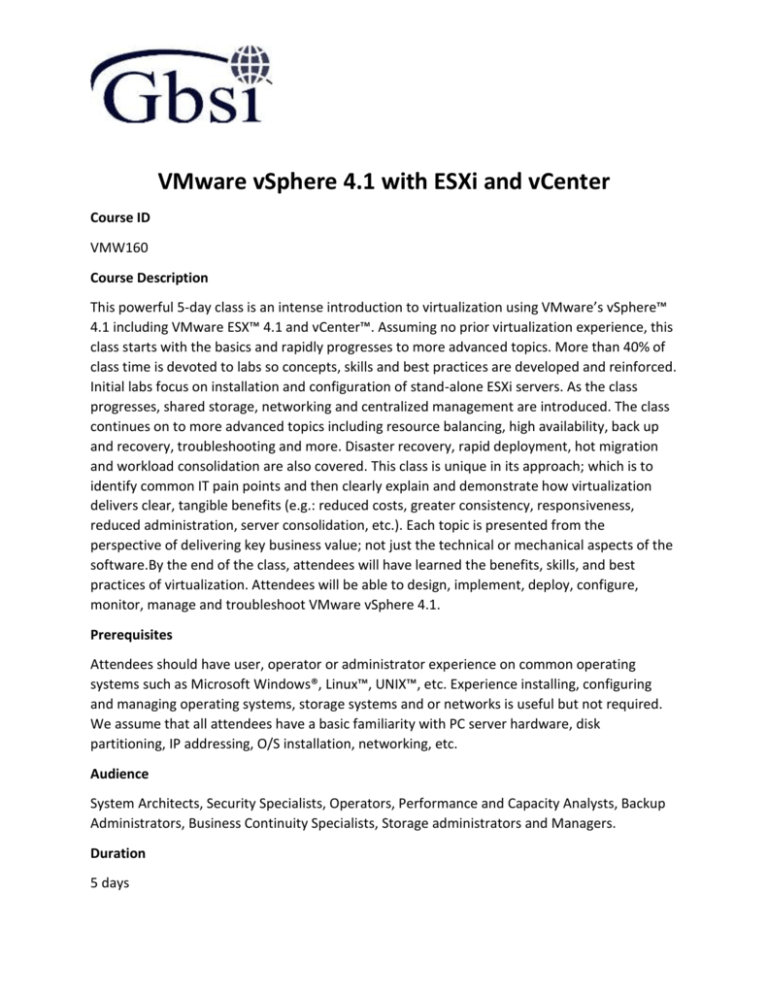
VMware vSphere 4.1 with ESXi and vCenter Course ID VMW160 Course Description This powerful 5-day class is an intense introduction to virtualization using VMware’s vSphere™ 4.1 including VMware ESX™ 4.1 and vCenter™. Assuming no prior virtualization experience, this class starts with the basics and rapidly progresses to more advanced topics. More than 40% of class time is devoted to labs so concepts, skills and best practices are developed and reinforced. Initial labs focus on installation and configuration of stand-alone ESXi servers. As the class progresses, shared storage, networking and centralized management are introduced. The class continues on to more advanced topics including resource balancing, high availability, back up and recovery, troubleshooting and more. Disaster recovery, rapid deployment, hot migration and workload consolidation are also covered. This class is unique in its approach; which is to identify common IT pain points and then clearly explain and demonstrate how virtualization delivers clear, tangible benefits (e.g.: reduced costs, greater consistency, responsiveness, reduced administration, server consolidation, etc.). Each topic is presented from the perspective of delivering key business value; not just the technical or mechanical aspects of the software.By the end of the class, attendees will have learned the benefits, skills, and best practices of virtualization. Attendees will be able to design, implement, deploy, configure, monitor, manage and troubleshoot VMware vSphere 4.1. Prerequisites Attendees should have user, operator or administrator experience on common operating systems such as Microsoft Windows®, Linux™, UNIX™, etc. Experience installing, configuring and managing operating systems, storage systems and or networks is useful but not required. We assume that all attendees have a basic familiarity with PC server hardware, disk partitioning, IP addressing, O/S installation, networking, etc. Audience System Architects, Security Specialists, Operators, Performance and Capacity Analysts, Backup Administrators, Business Continuity Specialists, Storage administrators and Managers. Duration 5 days Course Content Virtualization Infrastructure Virtualization explained How VMware virtualization compares to traditional PC deployments Common pain points in PC Server management How virtualization effectively addresses common IT issues VMware vSphere software products How to Install ESXi 4.1 Installable Understanding ESXi Selecting, validating and preparing your server Storage controllers, disks and partitions Software installation and best practices Joining ESXi to a Domain First look at the VMware vSphere Client Virtual and Physical Networking vNetwork standard and distributed virtual Switches Virtual Switches, Ports and Port Groups Creating VMkernel ports Creating, sizing and customizing Virtual Switches NAS Shared Storage Benefits Shared Storage offer to Virtual Infrastructure Shared Storage options NFS Overview Configuring ESX to use NFS Shares Troubleshooting NFS connections Virtual Hardware and Virtual Machines VM virtual hardware, options and limits Sizing and creating a new VM Assigning, modifying and removing Virtual Hardware Working with a VM’s BIOS VMware remote console applications Installing an OS into a VM Driver installation and customization Chapter 6 – vCenter vCenter feature overview and components VMware Licensing Organizing vCenter's inventory views Importing ESX hosts into vCenter management Troubleshooting vCenter VM Rapid Deployment using Templates, Clones Templates - Virtual Machine Golden Master images Creating, modifying, updating and working with Templates Patching, and refreshing Templates Cloning, one time copies of VMs Best practices for cloning and templating ESXi and vCenter Permission Model VMware Security model Configuring local users and groups Managing local permissions vCenter security model Local, Domain and Active Directory users and groups How permissions are applied Advanced Virtual Networking Uplinking Virtual and Physical Network segments using NICs Distributed virtual switches and distributed Port Groups NIC teaming for redundancy and Performance Connecting to vLANs Enhanced Network Security Virtual routers and firewalls Assigning physical NICs to VMs Using Fibre and iSCSI Shared Storage Fibre SAN overview Identifying and using Fibre Host Bus Adapters Scanning and Rescanning Fibre SANs iSCSI overview Virtual and physical iSCSI adapters Connecting to iSCSI storage Scanning and rescanning iSCSI SANS Performance and redundancy considerations and best practices VMware File System (VMFS) Unique file system properties of VMFS Managing shared Volumes Creating new VMFS partitions Managing VMFS capacity with LUN spanning and LUN expansion Native and 3rdparty Multipathing with Fibre and iSCSI SANs VMFS performance considerations Resource Management and Resource Pools How ESX delivers resources to VMs Shares, Reservations and Limits CPU resource scheduling Memory resource scheduling Resource Pools Guided Consolidation Use Guided Consolidation to discover, Domains, Workgroups and servers Extract hardware profiles from select servers Monitor physical server resource consumption Select and convert physical servers to VMs VM Hot and Cold Migration, Storage VMotion Cold Migrations to new ESX hosts, datastores Hot Migrations with VMotion VMotion requirements and dependencies How VMotion works – detailed explanation Troubleshooting VMotion Storage VMotion for hot VM disk migrations Load Balancing w. Distributed Resource Scheduler Delegated resource management with Resource Pools Resource balanced clusters with VMware Distributed Resource Scheduler DRS Cluster configuration and tuning Per-VM cluster policy overrides Failure Recover with High Availability Clusters High Availability options to minimize unplanned down time VMware High Availability clusters VMware Fault Tolerance Back Up, Recovery Pro’s and Con’s of traditional back up strategies Backing up VMs with VMware Data Recovery Backing and restoring your ESXi server configuration Third party VM back up solutions Consolidation with vCenter Converter vCenter Converter overview Converting physical machines, virtual machines and OS Images Cold migrations of physical machines to virtual machines Hot migrations of physical machines to virtual machines ESX and vCenter Alarms Alarm categories and definitions Creating custom alarms and actions Reviewing alarms and acknowledging them Managing Scalability and Performance VMkernel CPU and memory resource management mechanisms Tuning VM storage I/O performance Identifying and resolving resource contention Monitoring VM and ESX host performance Performance and capacity planning strategies Patch Management with VMware Update Manager Configure and enable VMware Update Manager Establishing a patch baseline Verifying compliance and patching ESXi hosts Final Thoughts Consolidation guidelines for VMs and Storage Determining which workloads to consolidate Other considerations
